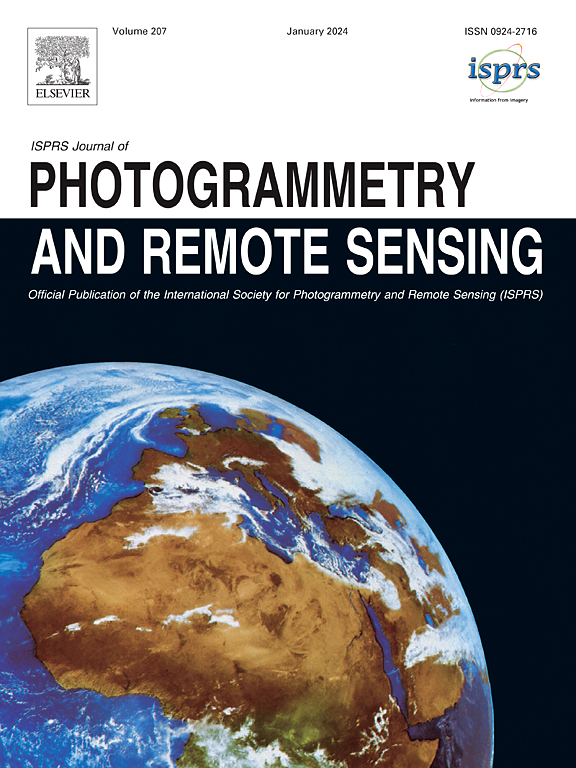Global high categorical resolution land cover mapping via weak supervision
IF 10.6
1区 地球科学
Q1 GEOGRAPHY, PHYSICAL
ISPRS Journal of Photogrammetry and Remote Sensing
Pub Date : 2025-02-01
DOI:10.1016/j.isprsjprs.2024.12.017
引用次数: 0
Abstract
Land cover information is indispensable for advancing the United Nations’ sustainable development goals, and land cover mapping under a more detailed category system would significantly contribute to economic livelihood tracking and environmental degradation measurement. However, the substantial difficulty in acquiring fine-grained training data makes the implementation of this task particularly challenging. Here, we propose to combine fully labeled source domain and weakly labeled target domain for weakly supervised domain adaptation (WSDA). This is beneficial as the utilization of sparse and coarse weak labels can considerably alleviate the labor required for precise and detailed land cover annotation. Specifically, we introduce the Prototype-based pseudo-label Rectification and Expansion (PRE) approach, which leverages the prototypes (i.e., the class-wise feature centroids) as the bridge to connect sparse labels and global feature distributions. According to the feature distances to the prototypes, the confidence of pseudo-labels predicted in the unlabeled regions of the target domain is assessed. This confidence is then utilized to guide the dynamic expansion and rectification of pseudo-labels. Based on PRE, we carry out high categorical resolution land cover mapping for 10 cities in different regions around the world, severally using PlanetScope, Gaofen-1, and Sentinel-2 satellite images. In the study areas, we achieve cross-sensor, cross-category, and cross-continent WSDA, with the overall accuracy exceeding 80%. The promising results indicate that PRE is capable of reducing the dependency of land cover classification on high-quality annotations, thereby improving label efficiency. We expect our work to enable global fine-grained land cover mapping, which in turn promote Earth observation to provide more precise and thorough information for environmental monitoring. Our data and code will be available publicly at https://zhu-xlab.github.io/PRE-land-cover.html.
基于弱监督的全球高分类分辨率土地覆盖制图
土地覆盖信息对于推进联合国的可持续发展目标是不可或缺的,在更详细的类别系统下绘制土地覆盖地图将对经济生计跟踪和环境退化测量作出重大贡献。然而,获取细粒度训练数据的巨大困难使得这项任务的实现特别具有挑战性。在此,我们提出将完全标记的源域和弱标记的目标域结合起来进行弱监督域自适应。这是有益的,因为使用稀疏和粗糙的弱标签可以大大减轻精确和详细的土地覆盖标注所需的劳动。具体来说,我们引入了基于原型的伪标签纠偏和扩展(PRE)方法,该方法利用原型(即类特征质心)作为连接稀疏标签和全局特征分布的桥梁。根据特征到原型的距离,评估在目标域的未标记区域预测的伪标签的置信度。然后利用这种置信度来指导伪标签的动态扩展和整改。基于PRE,我们利用PlanetScope、高分一号和哨兵二号卫星影像,对全球不同地区的10个城市进行了高分类分辨率的土地覆盖制图。在研究区域,我们实现了跨传感器、跨品类、跨大陆的WSDA,总体准确率超过80%。结果表明,PRE能够减少土地覆盖分类对高质量标注的依赖,从而提高标注效率。我们希望我们的工作能够实现全球细粒度的土地覆盖测绘,从而促进地球观测,为环境监测提供更精确和全面的信息。我们的数据和代码将在https://zhu-xlab.github.io/PRE-land-cover.html上公开。
本文章由计算机程序翻译,如有差异,请以英文原文为准。
求助全文
约1分钟内获得全文
求助全文
来源期刊

ISPRS Journal of Photogrammetry and Remote Sensing
工程技术-成像科学与照相技术
CiteScore
21.00
自引率
6.30%
发文量
273
审稿时长
40 days
期刊介绍:
The ISPRS Journal of Photogrammetry and Remote Sensing (P&RS) serves as the official journal of the International Society for Photogrammetry and Remote Sensing (ISPRS). It acts as a platform for scientists and professionals worldwide who are involved in various disciplines that utilize photogrammetry, remote sensing, spatial information systems, computer vision, and related fields. The journal aims to facilitate communication and dissemination of advancements in these disciplines, while also acting as a comprehensive source of reference and archive.
P&RS endeavors to publish high-quality, peer-reviewed research papers that are preferably original and have not been published before. These papers can cover scientific/research, technological development, or application/practical aspects. Additionally, the journal welcomes papers that are based on presentations from ISPRS meetings, as long as they are considered significant contributions to the aforementioned fields.
In particular, P&RS encourages the submission of papers that are of broad scientific interest, showcase innovative applications (especially in emerging fields), have an interdisciplinary focus, discuss topics that have received limited attention in P&RS or related journals, or explore new directions in scientific or professional realms. It is preferred that theoretical papers include practical applications, while papers focusing on systems and applications should include a theoretical background.
 求助内容:
求助内容: 应助结果提醒方式:
应助结果提醒方式:


